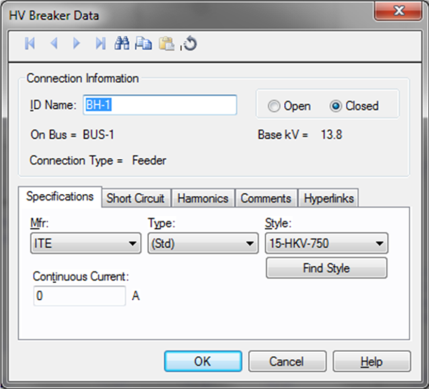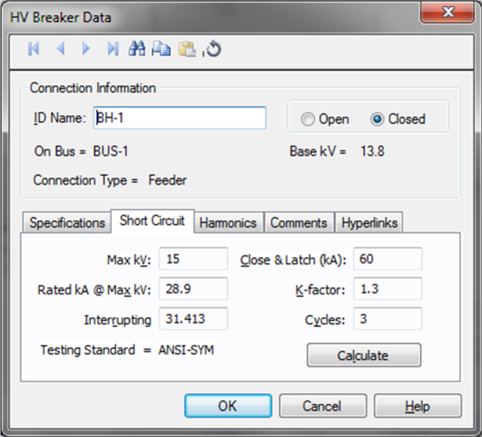
This dialog box includes the following areas and tabs:

Figure 1: HV (High Voltage) Breaker Data Dialog Box
ID Name: Uniquely identifies the high voltage breaker. This ID name is sometimes referred to as the high voltage breaker name, and can be up to 12 characters long. The names default to BH-1, BH-2, BH-3, and so on as you enter new high voltage breakers on the one-line diagram, but you can change those names if needed.
Open/Closed: Normal state of the high voltage breaker. If Open is selected, the one-line will displays “OPEN” next to the high voltage breaker symbol. If Closed is selected, the one-line symbol does not display any text.
On Bus: The bus to which the high voltage breaker connects, which must already exist on the one-line. For your reference, the On Bus base kV is displayed next to the bus name.
Connection Type: Whether the high voltage breaker is connected as a “Feeder,” (such as to a cable, busway, transformer) or as a “Tie” (between two buses).
Mfr: Provides a list of high voltage breaker manufacturers available in the device library. After you select a manufacturer, the available styles are displayed in the Style field. If the desired manufacturer is missing from the list, choose Other.
Type: High voltage breaker types available from the manufacturer chosen in the Mfr field above.
Style: High voltage breaker styles which correspond to the yellow column on the device library page for the manufacturer and type chosen.
Find Style: Click to search for a specific style of breaker. You can do a partial character search or perform an exact match search.
Continuous Current: The continuous current of the high voltage breaker. This value is for reference only and does not affect analysis.

Max kV: Maximum voltage for which the breaker is designed and the upper limit for operation.
Rated kA @ Max kV: Rated interrupting kA of the breaker at the breaker’s maximum voltage.
Interrupting (kA): Interrupting rating of the breaker.
Close & Latch (kA): Close & latch rating of the breaker.
K-factor: Ratio of rated maximum voltage to the lower limit of the range of operating voltage in which the required symmetrical and asymmetrical interrupting capabilities vary in inverse proportion to the operating voltage.
Cycles: Interrupting time of the breaker in cycles.
Testing Standard: The data in the library for the breaker is applicable for the specified test standard. The following testing standards are defined:
Calculate: Fills in computed values for the Max kV, Rated kA @ Max kV, K-factor, Cycles, Interrupting, and Close & Latch fields, based on the device library entry for Mfr, Type, Style and the base kV. You can override these values by typing in different numbers. This button also causes the appropriate Testing Standard to be displayed for your information. (The Testing Standard comes directly from the device library and cannot be changed.)
EasyPower can monitor whether or not the IEEE 519 guideline for harmonics is met at the point of common coupling.
Monitor IEEE 519 Point of Common Coupling: If selected, then the Harmonics Report indicates when this guideline is not being met.
kVA Demand: The kVA Demand.
PCC Isc/Load: The ratio of short circuit current to load current at the point of common coupling.
This tab is read-only and appears only if you have imported data from an SKM Data Format file. See Importing an SKM Format File for more information.
See Comments for information.
See Hyperlinks for information.
| Database Technical Reference |